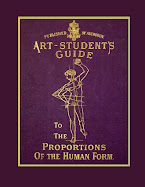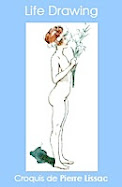

William Rimmer
New copies of the book and original editions are available at Abebooks.com.
From the publisher's notes:
"The book contains nearly nine hundred drawings, illustrating in the fullest manner the ethnological, bony, anatomical, and artistic construction, movement (both simple and composite), and purposes of the human form, of both sexes and all ages, as well as the expression of the passions, will full explanatory text on the same page with the drawings. The drawings are for the most part in outline, and are made with great firmness and beauty. Many of the figures are statues in their conception. There is one full-page composition, entitled the Call to Arms. The "Art Anatomy" is the most perfect compendium of pictorial and artistic knowledge on this subject that I have ever seen, and without doubt unique."
"It has been said that William Rimmer's reputation rests most soundly upon his art anatomy. I believe there can be no disputing this. In the plates of his anatomical drawings we find nearly 900 drawings, not notes or sketches, but master products of a pencil craftsman and works of art of the first order. He begins with the skull; the first chart contains nine drawings, each illustrating a different aspect of the head, beginning with its basic structure, and in the last drawing showing muscular attachments. From this he carries the student through a most exhaustive study of the human head—unquestionably the most marvelous of all created things. Of the eighty-one charts, thirty-one are given to this study of the head, physically, artistically, and psychologically. He deals with primitive and highly developed forms, comparing and emphasizing the characteristics that civilization retains and those called elemental.
"This thoroughness one finds in all Rimmer's activities. A wonderful mind, wonderful visualization, and an imagination which contemplated all that was worth while or great in nature and art."
From Nineteenth Century Art Worldwide, Life Drawing from Ape to Human: Charles Darwin's Theories of Evolution and William Rimmer's Art Anatomy by Elliott Bostwick Davis.
Excerpts from Art Anatomy by William Rimmer at Scott-Eaton.com.

From the Literary Digest, Volume 70:
OUR PROPHET UNHONORED IN ART
A PROPHET IS NOT THE ONLY ONE who may be without honor in his own country. So may an artist and sculptor be unhonored and unsung, even tho, in the words of Gutzon Borglum , the sculptor, he be "the superior of Leonardo da Vinci
, the sculptor, he be "the superior of Leonardo da Vinci and Michelangelo
and Michelangelo in the delineation of various forms of art anatomy." Dr. William Rimmer, of Boston, who died in 1879, is the artist of whom Mr. Borglum writes so enthusiastically under the above title in the New York Evening Post. "In sculpture he worked more like Rodin
in the delineation of various forms of art anatomy." Dr. William Rimmer, of Boston, who died in 1879, is the artist of whom Mr. Borglum writes so enthusiastically under the above title in the New York Evening Post. "In sculpture he worked more like Rodin at Rodin's best than any man in modern times," we are told. "Rimmer probably never heard of Rodin; it appears that he never went abroad, yet it is curious that he dealt with form with that strange, intense, plastic quality and that mastery of structural modeling which we see only in Rodin and one or two of his greatest contemporaries." Continues Sculptor Borglum of Sculptor Rimmer:
at Rodin's best than any man in modern times," we are told. "Rimmer probably never heard of Rodin; it appears that he never went abroad, yet it is curious that he dealt with form with that strange, intense, plastic quality and that mastery of structural modeling which we see only in Rodin and one or two of his greatest contemporaries." Continues Sculptor Borglum of Sculptor Rimmer:
"How such a force could have lived in New England and thought, talked, modeled, and painted as he did for a long lifetime (in the memory of many still alive) without recognition is utterly incomprehensible. In so far as his great ability and his great productions affected the civilization of his environment, he might as well have been in Greenland. The truth is that Rimmer was not seen, not understood, because there was no one to understand him.
"What seems more remarkable still is that he is yet unknown. Artists do not know him. Recently at a little dinner I referred to him. My fellow guests were among the ablest of our painters and sculptors. Only one out of six had even heard of him. He is unknown in the schools. I did not learn of him through the regular art channels. I found his book of drawings in the possession of an American lady of the generation of Rimmer. I borrowed it. I lost all interest in the world for a week after my discovery, and grew angry and despaired over a world that knew nothing of it. Later I found that Truman Bartlett had written his life, and that the cellar of the Boston Museum had long been the vault wherein many of his fragments were neglected or lost." ,
In the sixties and seventies Dr. Rimmer was known in Boston art circles as a remarkable lecturer on art anatomy, Mr. Bartlett says in his bock, as the sculptor of several statues and busts, and as a man who had painted much without establishing a reputation as a painter. Yet,-Mr. Borglum assures us, "I have seen nothing in the records of art by the great Italian masters (excepting a few works of Da Vinci) that is comparable with Dr. Rimrner's drawings as studies not only of anatomy but of character." This modern sculptor then goes on:
"Unless it be a few of Holbein
"The story runs that this benefactress of humanity asked Dr. Rimmer if ho could not or would not make some of these drawings permanent so that the world might have them. He said that he would be glad to do it. She told him that she had a couple of thousand dollars she did not need, and asked him to take the money and do as much as he felt would be right for such a sum. With it he produced these ninety-odd pages, all of which are masterpieces for what they illustrate as well as works of art in character of line and general rendering. Half of them, at least, excel any drawings extant in pure beauty and as masterful demonstrations of knowledge of the human figure. They have a character of truth without exaggeration that is not unlike the Greek. The man is inspired by the same beauty and drama as the Italian Angelo, and in his drawings of hands and feet we feel the influence of the Renaissance masters, but in the form and structure of the figure and its proportion he is Greek."
From Ptak Science Notes, Dadaist Images in 19th Century Prints: William Rimmer's Artistic Anatomy, 1877
Conscience Continuum Blog.
ART: WILLIAM RIMMER WORKS ON EXHIBITION - The New York Times Review
ArtMagick Biography.
EVENING OR THE FALL OF DAY and FLIGHT AND PURSUIT
by William Rimmer (1816 — 1879) - Mindworkshop.com a post written by William Rimmer's great-great-great nephew.

Art Anatomy
Art anatomy
Art Anatomy
From The Century Illustrated Monthly Magazine, Volume 25:
Dr. RlMMER is one of the many figures in American art that fill one with uneasiness. The artistic genius in this country, until recently, has had no place. In other circumstances Rimmer might have achieved more satisfactory results ; here everything was against him, though perhaps nothing was so much against him as a disquiet and pride inherited from a father who believed himself a prince by birth, and his own inherent lack of patience and humble teachableness. He had a strong artistic temperament, but was thorough in nothing except anatomy. In that he was an excellent theoretic teacher, though he always disapproved of dissection for art-students, and, in explaining the most difficult parts of interior anatomy, would use the blackboard only.
Rimmer made his strongest impression not in his studied designs, pictures, and modelings, but at the blackboard. He had a most facile pencil, and would improvise on the blackboard as a musician does on the key-board, producing varied and beautiful harmonies of line. He was eminently a draughtsman, caring little for the illusion which a picture-maker is apt to cherish. He was totally ignorant of color, and took very uncertain interest in form as such ; but line as a rapid means of expressing a situation, an idea, a passion, was always at his own command, and strongly moved him in such men as Rembrandt and Michael Angelo. His enormous egotism not only prevented him from understanding and learning from his immediate contemporaries, but kept him from acknowledging indebtedness to an older artist like Allston (whom he was doubtless affected by), or to a modern master like Blake, who also evidently had a decided effect upon his thought.
Atlantic Monthly. Volume 74, Books on Architecture and Art.
How to Draw People at Figure-Drawings.com
How to Draw Proportions at Figure-Drawings.com



















No comments:
Post a Comment